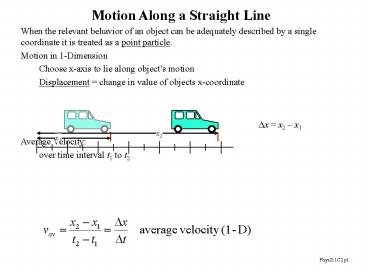Motion Along a Straight Line - PowerPoint PPT Presentation
1 / 15
Title:
Motion Along a Straight Line
Description:
When the relevant behavior of an object can be adequately described by a single ... How much time elapses before the officer catches up with the motorist? ... – PowerPoint PPT presentation
Number of Views:163
Avg rating:3.0/5.0
Title: Motion Along a Straight Line
1
Motion Along a Straight Line
When the relevant behavior of an object can be
adequately described by a single coordinate it is
treated as a point particle. Motion in
1-Dimension Choose x-axis to lie along objects
motion Displacement change in value of objects
x-coordinate Average Velocity over time
interval t1 to t2
Dx x2 x1
2
Instantaneous Velocity Rate at which displacement
changes with time
http//phys23p.sl.psu.edu/simulations/1d_motion.ip
slope of graph of x versus t. generally not equal
to instantaneous velocity. /- slope for /-
velocity (direction!) motion away from/towards
the origin
3
Average acceleration A change in the
(instantaneous) velocity with time
acceleration is not the same as velocity!
Instantaneous acceleration Rate at which velocity
changes with time
4
What can be said about displacement, velocity and
acceleration at and between t1 and t2?
x-t graph
x
t
t1
t2
x-t graph
x
t
t1
t2
5
What can be said about displacement, velocity and
acceleration at and between t1 and t2?
v-t graph
v
t
t1
t2
v-t graph
v
t
t1
t2
6
Motion with constant acceleration a simplified
model for many useful situations a aav a
constant means v-t graph is a straight line with
the conventions velocity is v at time t,
velocity is v0 at time 0
7
Velocity and Acceleration
final velocity initial velocity change in
velocity
v
v
v
t
v0
v
v0
t
v
v
t
v0
v
v0
t
v
8
constant acceleration a with the
conventions position is x, velocity is v at time
t, position is x0, velocity is v0 at time 0
9
One final useful relation, take
10
Summary
For a particular problem, use an equation which
only has one unknown
11
Example 2-4 A motorcyclist heading east is 5.00m
past the city limits sign (taken to be the
origin) at a speed of 15.0 m/s. His acceleration
is 4.00 m/s2. Find his position and velocity 2.00
s later. Where is the motorcycle when his
velocity is 25.0 m/s. First identify known
quantities, then identify appropriate equation to
solve for desired unknown.
12
Example 2-5 A motorist traveling with a constant
velocity of 14 m/s (about 34 mph) passes a school
crossing, where the speed limit is 15 mph. Just
as the motorist passes, a police officer on a
motorcycle waiting at the crossing accelerates at
a rate of 3.00 m/s2 in hot pursuit of the
motorist. How much time elapses before the
officer catches up with the motorist? What is the
officers speed at this point? How far beyond the
crossing are the vehicles at this point?
13
Free fall under the influence of
gravity Aristotles vs Galileos picture of
motion acceleration due to gravity (on the
surface of the Earth) air resistance can be
ignored acceleration is downward if positive
direction is taken to be upward, a -g
14
Example 2-6 An object is dropped from the top of
a very tall building. How far has it dropped and
how fast is it moving after 1.00s? 2.00s? 3.00s?
15
Example 2-7,8 An object is thrown straight
upward with a speed of 15.0 m/s from the roof of
a very tall building. On the way down, it just
misses the railing. Find the position and
velocity of the object 1.00 and 4.00 seconds
after being thrown. Find the velocity when the
object is 5.00 m above the railing. Determine the
maximum height reached, and the time at which it
is reached. The acceleration of the object when
it is at its maximum height. At what time is the
object 5.00 m below the railing?































